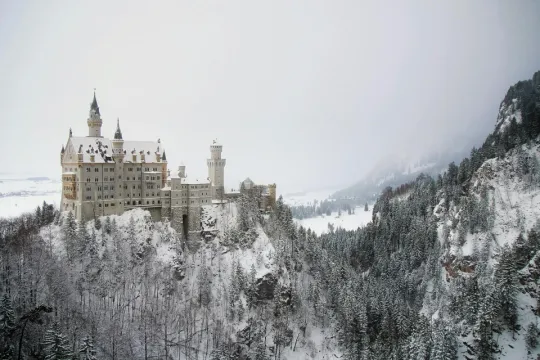Neuschwanstein: the fairytale castle in the heart of Bavaria

Among Europe's many castles, few are as fascinating as Neuschwanstein Castle. Located in Bavaria, southern Germany, perched on a hill overlooking the Allgäu Mountains, this castle looks like it came straight out of a fairy tale. With its soaring towers, white facades, and enchanting setting, it is one of the most photographed monuments in the world. But behind this romantic image lies a complex story of dreams, madness, art, and tragedy.
A castle born from a dream
Neuschwanstein Castle was built in 1869 by King Ludwig II of Bavaria, nicknamed the "Mad King." A lover of art, music, and medieval legends, this ruler wanted to create a refuge where he could escape the constraints of power and live in an idealized world inspired by the operas of his friend and idol, Richard Wagner.
Unlike medieval castles, Neuschwanstein was not designed for defensive purposes, but as a complete work of art. Ludwig II wanted to recreate a romantic and chivalrous universe, a fusion of Gothic fantasy and 19th-century technology.
A titanic project
Construction of the castle began in 1869 on the ruins of an ancient medieval castle. It involved hundreds of workers, craftsmen, architects, and decorators. The initial project was colossal: 200 rooms were planned, richly decorated walls, frescoes inspired by Germanic legends and Wagner operas, stained-glass windows, balconies overlooking the Alps, and much more.
But Ludwig II, a perfectionist and increasingly reserved, constantly modified the plans, leading to numerous delays and budget overruns. By the time of his death in 1886, the château was far from complete. Only about fifteen rooms were fully finished. Yet this fragment of a dream was enough to capture the imagination of the entire world.
Architecture inspired by Romanticism
Neuschwanstein is a masterpiece of the neo-romantic style. Inspired by German and French medieval castles and Germanic myths, it combines several architectural influences:
- Slender towers and turrets , reminiscent of the Loire Valley castles.
- White facades with dark roofs, creating a striking contrast.
- Sumptuous interior decoration , where each room tells a story.
Among the emblematic rooms:
- The throne room : gigantic, decorated with golden mosaics, but without a throne – because it was never installed.
- The Singers' Hall : dedicated to Wagnerian art, it resembles an opera stage.
- The King's Chamber : Richly decorated in a flamboyant Gothic style, with a hand-carved bed.
A modern castle for its time
Despite its medieval appearance, Neuschwanstein was technologically advanced:
- Central hot air heating .
- Maid call system .
- Flush toilets (quite rare at the time).
- Modern kitchen with dumbwaiter.
Ludwig II wanted his refuge to be as comfortable as it was impressive, combining ancient dreams with modern innovations.
A tragic end
Ludwig II's fate remains shrouded in mystery. Declared unfit to reign in 1886 for controversial psychiatric reasons, he was arrested and interned. A few days later, he was found dead in Lake Starnberg along with his psychiatrist, in circumstances that have never been fully clarified. His death ended his dream, but Neuschwanstein thus began a new life.
A few weeks after the king's death, the castle was opened to the public to recoup construction costs. Ironically, this place, designed for seclusion, became one of the most visited tourist sites in Europe.
The castle today
Every year, more than 1.5 million visitors pass through the gates of Neuschwanstein. During peak season, more than 6,000 people come daily to admire this jewel suspended between the sky and the mountains.
The castle has also left its mark on popular culture:
- It inspired Disney's Sleeping Beauty Castle .
- He has appeared in numerous films, series and commercials.
- It has become a symbol of romantic Germany and a must-see for Bavarian tourism.
Despite the crowds, the magic still works: the panorama of the Alps, the Marienbrücke bridge suspended over a ravine, the golden light at sunset... Everything contributes to a timeless experience.
Practical advice for the visit
How to access it?
Neuschwanstein is located near the village of Hohenschwangau , about a two-hour drive from Munich. It can be reached by car, tourist bus, or train to Füssen, then by shuttle bus.
On foot or by horse-drawn carriage?
From the village, you have to walk up (40 minutes) or take a horse-drawn carriage or shuttle to reach the castle.
Book in advance
Tickets must be booked in advance , especially in summer. Tours are guided and available in several languages.
A lasting legacy
Neuschwanstein is not just a castle: it is a symbol. It represents the collision between individual dreams and historical reality, between art and madness, between the idealized past and modernity. Ludwig II, often mocked during his lifetime, is today recognized as a visionary patron of the arts.
Its unfinished yet sublime castle embodies a sense of mystery and idealism that transcends time. Neuschwanstein reminds us that some dreams, even unfinished ones, can endure for centuries and continue to amaze humanity.
Discover Neuschwanstein, Bavaria's magical castle, a blend of dreams, art, and modernity. Built by King Ludwig II, this neo-romantic gem captivates with its architecture, tragic history, and cultural influence. A must-see for lovers of castles and legends.